14 Basement Shelving Ideas & Design Tips (with Pictures)
-
- Last updated:
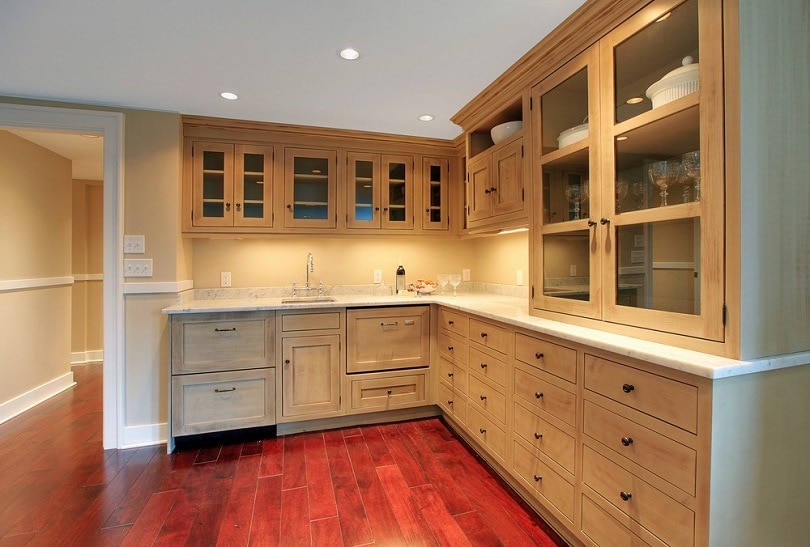

In the US, basements are commonly used as utility space for heaters, furnaces, breaker panels, and laundry machines. They have one job: to free up space upstairs. However, the basement is more than just another floor buried under the ground. It’s a place where we can work, relax after a rough day, and talk to friends in a casual environment.
It’s also where we store most of our stuff, be it vintage gadgets, car parts, old clothes, and, of course, canned food. Unfortunately, over time, most storerooms grow into a cluttered, chaotic mess. But you can always turn things around, and we have the perfect shelving ideas for tidying up the basement and making every inch count!

The 14 Basement Shelving Ideas
1. Basement Turned Bar/Lounge Area
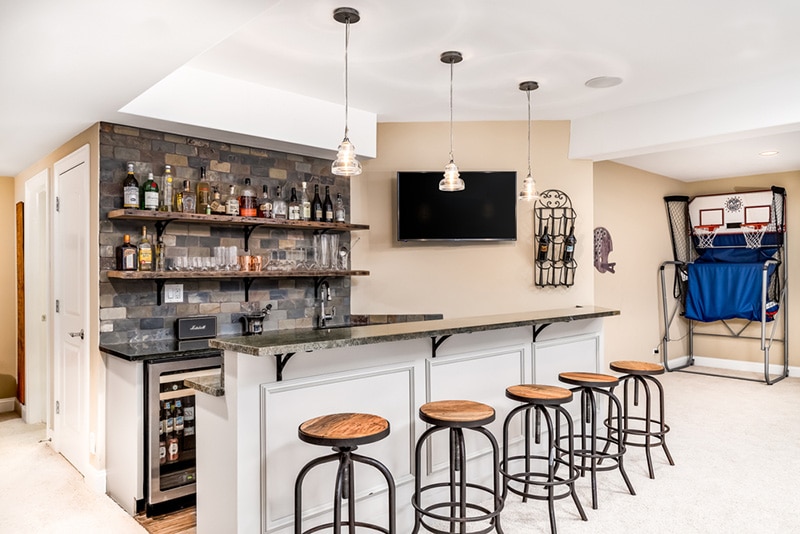
In contrast to popular belief, it doesn’t take much effort to transform a regular basement into an improvised bar. All you’ll need is a couple of shelves for the drinks, a set of stools, and a TV with the game on—that’s pretty much it. If you only have a dozen bottles or so, a pair of shelves will be enough. Essentially, it all depends on how much alcohol you have and the available space in the basement.
Also, take a day or two to experiment with the light fixtures, the number of stools (or maybe replace them with chairs), and the overall layout.
2. Embracing Old-School Pantry Vibes
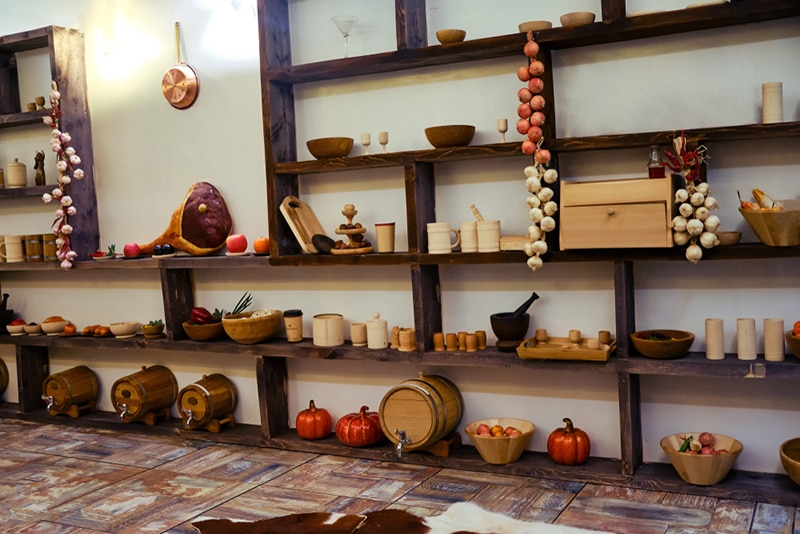
Back in the day, people used to store goods in cellars for the winter. These days, we have fridges and cabinets in the kitchen, but sometimes, there simply isn’t enough room. That’s why most basements today are used for storing food, drinks, grains, dried fruits or veggies, and other products that can last for many years or even decades. To maximize the available space, divide each shelf into multiple smaller sections.
This has proven to be an effective technique for making the most out of limited storage capacity.
3. Wooden Shelves for Storing Wine

Keeping wine in the cellar is an all-time classic. And you don’t need to have a huge collection of thousand-dollar bottles to store them in the basement. You can put vino next to vodka, tequila, whisky, or scotch. Now, shelves that were specifically made for preserving wine aren’t that cheap; plus, you might have to order a custom setup that fits your basement.
So, think everything ahead before you spend big bucks on a carpenter or cases of expensive spirits. Chances are that your wine collection will easily fit on a simple wooden shelf.
4. Furniture With Hidden Storage
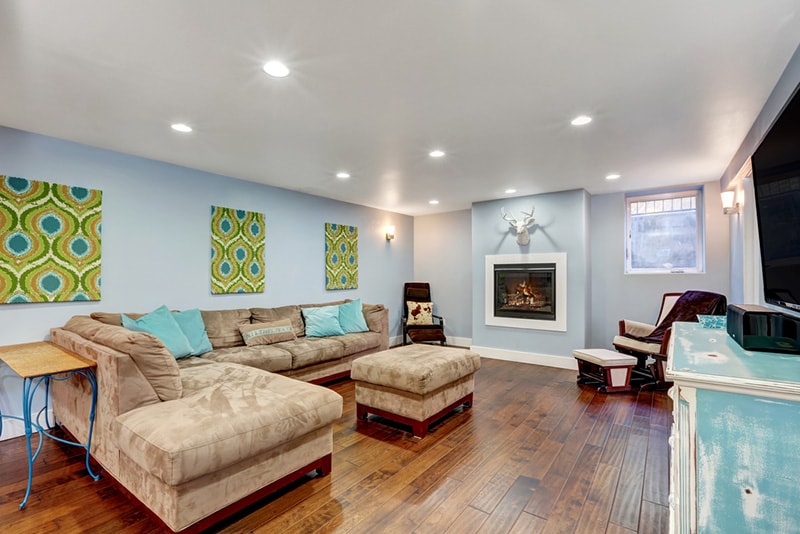
There can never be too much space in a basement—that’s a universal rule. Therefore, if you want to have lots of legroom and traffic flow and still store some stuff down there, opt for furniture with compartments. It can be an ottoman, bench, or even a couch. This is a perfect example of killing two birds with one stone: You get to keep the room clutter-free while taking care of storage.
Corner couches are the best option here, by the way, as they tend to be larger than regular sofas and have more room for your clothes, blankets, and old toys.
5. Using the Space Underneath the Stairs

Most folks tend to neglect the precious square feet below the stairs that lead into the basement. But we’re here to change that! Depending on how big the basement is, you should be able to fit a couple of shelves and a cabinet or two underneath the staircase. To make even better use of this storage area, fill it with things that you’d like to have quick access to.
For some people, it will be cleaning powder, towels, and stuff they need for the garden. Others will store dog food, packs of cat litter, and more pet-related products.
6. Perfect Balance of Comfort and Functionality
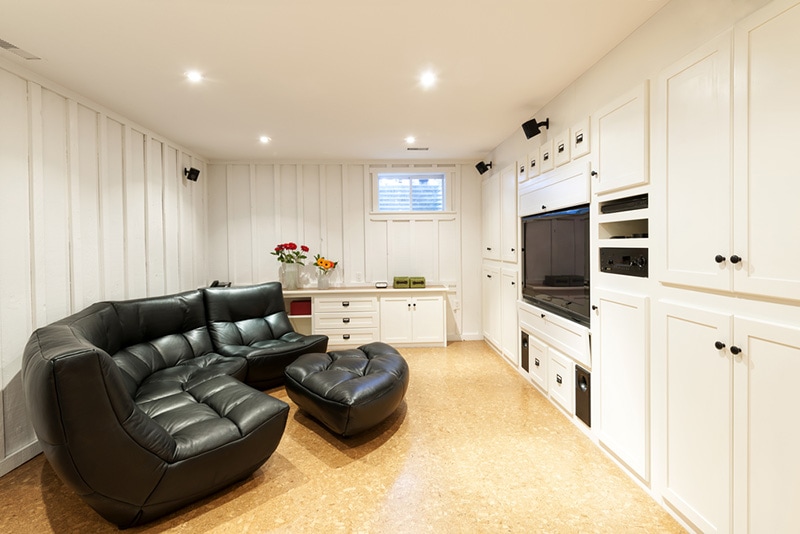
Who says you can’t have a basement that’s equally good for storage and as a recreational room? If you invest in an entertainment center, pair it with cabinets and drawers, and put a cozy couch on the other side, this can very well work! But, again, we encourage you to think everything through before introducing changes to the basement. First, see that there’s enough space for storage.
After that, pick a large enough couch (and maybe a chair) that offers enough seating yet doesn’t take away too much traffic flow. Comfort and practicality can, indeed, co-exist. It all comes down to picking the right furniture, shelves/stands, and not being afraid to experiment.
7. The Ultimate Recreation Room Setup

Here, we have a slightly different setup with a big focus on parties and having a good time instead of turning the basement into a warehouse. Now, if it’s a relatively small basement, you’ll only be able to fit a couch, a larger armchair, and a table in there, plus maybe a TV. On the other hand, if there’s enough room, don’t hesitate to designate 20–25% of the available space for storage.
Or put a couple of ottomans in the corner and add a kitchen zone—the choice, as always, is yours.
8. Underground Kitchen With Cabinets and Shelves
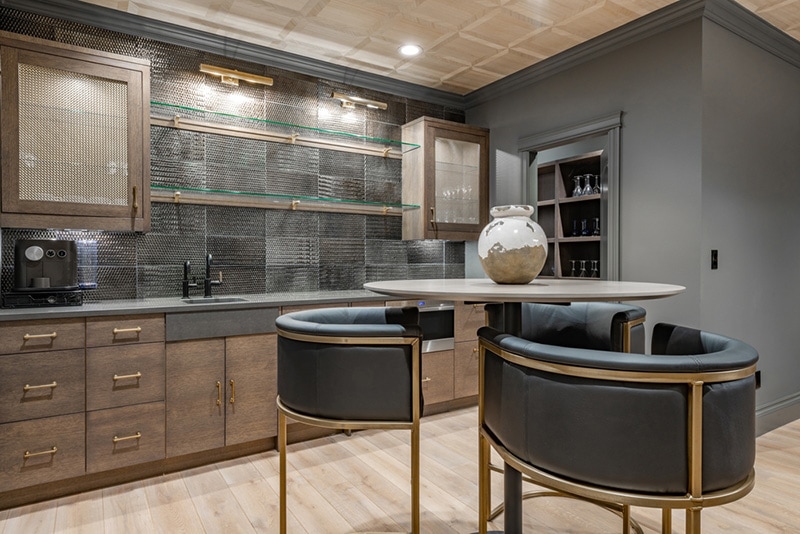
Speaking of the kitchen, it’s a great concept for basements, especially if you need both a lounge area and a place where you can store, cook, and serve food. First, pick the right cabinets, shelves, racks, and built-in storage compartments that don’t occupy half of the room but give you enough storage opportunities. A dining table with vintage, futuristic, or rustic chairs will also come in handy.
Oh, and if you recently bought new cabinets for the main kitchen upstairs, the old cabinets might be perfect for the basement.
9. Wood/Plastic Shelving Units for Cheap Storage
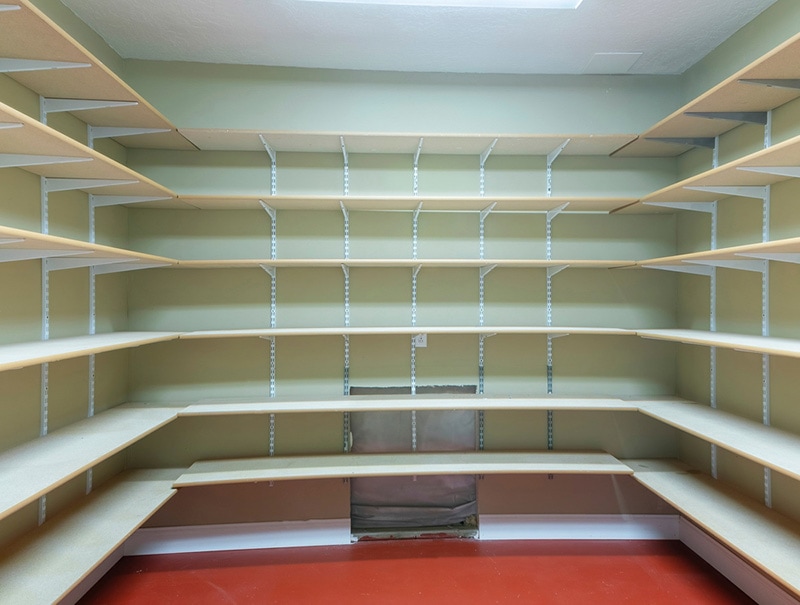
Don’t have a big enough budget for chairs, tables, entertainment centers, TVs, and cabinets/drawers? Don’t worry; you can just order a bunch of cheap shelves and use the basement exclusively for storage. And if you’re good with your hands and have basic carpentry gear and skills, it shouldn’t be hard to build these shelves manually.
10. Heavy-Duty Boards With Metal Supports

Not sure the shelves from the previous example will be able to hold something heavy? Consider putting together heavy-duty boards supported by metal rails. While these shelves don’t look fancy, they will get the job done, which is holding hefty things. It might also be a good idea to combine these two designs, like keeping the lighter shelves on the left side while putting these stronger ones on the right side.
This way, you’ll have a flexible setup for storing lightweight stuff like toys, papers, and electronics and some bulker loads like canned food, drinks, and firewood.
11. Built-In Shelves for Storing the Essentials

Sometimes, you don’t need to turn the entire basement into one big storage unit as you simply don’t have that many things to keep there in the first place. So, instead, we would suggest only utilizing a single wall or even half of the wall for storage and using the rest of the space as you see fit. That’s right: just store the essentials on in-wall shelves and call it a day.
12. Pegboards for Displaying Tools

Pegboards are perfect for putting tools, gear, and hardware on the walls. They’re cheap, easy to stick to most surfaces, and do a great job of displaying your entire toolbox. Pegboards are often praised by people who want to use the basement as a makeshift workshop. You’ll still need a shelf or two for the heavier equipment and all the nuts and bolts, of course.
13. Allocating a Corner for the Chores
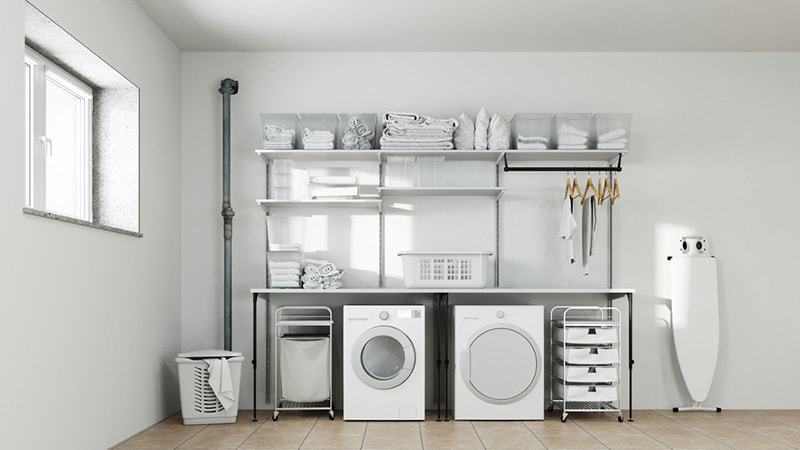
If you don’t want the washer and the laundry machine to ruin the vibes, the best solution would be to put them in the corner, along with the cleaning products, towels, blankets, baskets, and cabinets. The same rules apply to the furnace/heater, but it might be harder to move it around. That said, as long as the chores area doesn’t interfere with the lounge and storage zones, you won’t have to worry about anything.
14. Utilizing the Corners to Free Up Space
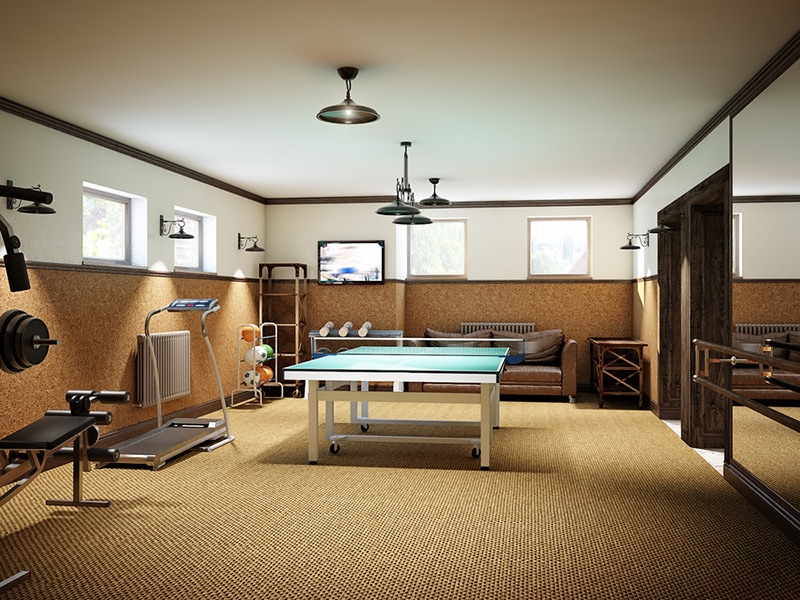
Corners don’t get enough love from homeowners, but they can make the basement look bigger and brighter. For example, if you put your favorite gym gear in the corners and close to the walls, that will free up space in the middle for other “man cave” elements like a tennis table, a luxurious rug, or something like that. A mirror on one of the walls can visually enhance the environment even further.
Basement Storage: How to Maximize the Available Space
The first thing you should do is throw away or move items that hold a sentimental value yet don’t have a practical purpose. These could be old toys, audio and video cassettes, or broken devices. All done? Great, now go ahead and measure how much free space you have in the basement and figure out how many shelves you need for proper storage.
If you have tons of stuff that won’t fit on regular racks, think about “carving out” built-in shelves. Custom stands are another great option: they put every single inch to good use. As for the materials, wood is a solid pick, but metal is better. It’s sturdier and isn’t afraid of humidity. Also, use hooks and pegs to free up space on the floor. Lastly, consider using cabinets or an entertainment center.
What Types of Food Can (and Should) You Store in the Basement?
The biggest problem with most basements is, of course, humidity. So, make sure the “underground floor” is dry and cool. Now, if we’re talking about food products, canned goods are an obvious choice here. The same goes for packaged foods, including unsalted nuts, pre-cut fruits and veggies, dried peas/beans, snacks (bars, chips, and crackers), and more.
Folks in the States also like storing grains and cereals. Those include wheat, oats, rice, corn, quinoa, and buckwheat. Root vegetables (carrots, potatoes, radishes, beets, and onions) will feel at home in the basement as well but might be a bit demanding in terms of temperature and moisture levels. Also, for some of this stuff, you’ll need airtight containers to protect it against moisture.
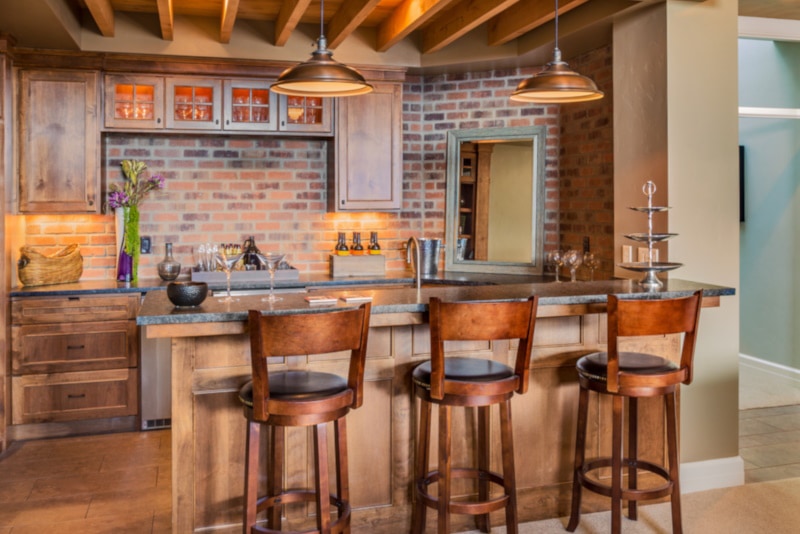
Things That Don’t Belong in a Humid Basement: A Quick Look
It’s not always easy to make the basement dry, moisture-free, and properly ventilated. So, if you’re dealing with humidity issues, here’s a quick look at the things not to store in the basement:
- Documents, diplomas, family photos, and other important papers (if you must, store them in airtight containers)
- Old books that still hold value (silverfish love chewing on the glue that holds the pages in a book together)
- Toys from your childhood that you want to keep for memory (dust mites and rats will make short work of them)
- Rugs, carpets, and furniture (they attract insects and mice and will be quickly ruined by the humidity)
- Old clothes (your favorite sweaters, jackets, and shirts will be “eaten alive” by moths, so use airtight bags)
- Firewood (the moisture will make even the most expensive wood rot and attract pests)
- Gas, propane, kerosene tanks, and paint buckets (don’t put flammable materials in the basement)
- Electronic devices that work (high moisture levels and temperature fluctuations ruin gadgets)
- Refrigerators (fridges have a hard time adjusting to extreme temps and may break down)
- Perishable goods (meat, fish, poultry, various dairy products, eggs, and more)

Conclusion
Do you feel like your basement is a dark, scary place that nobody wants to go down to? We feel your pain! The basement can rapidly get clogged with stuff that you don’t even remember putting there. On the bright side, we can always bring order and harmony into the cellar, and it usually starts with the shelves.
Today, we checked out amazing basement shelving ideas that help make the best out of the available space. Sometimes, all it takes to balance things out and find room for all the extras is to add a shelf. So, use our tips for maximizing storage space, pick a design that works for you, and get things going!
- https://www.budgetdumpster.com/blog/how-to-organize-basement/
- https://extension.umn.edu/moisture-and-mold-indoors/moisture-basements-causes-and-solutions
- https://www.familyhandyman.com/list/10-things-you-should-never-store-in-your-basement-or-crawl-space/
- https://ask.usda.gov/s/article/What-foods-are-perishable
Featured Image Credit: Artazum, Shutterstock
Contents

